Labrador Retriever Dog Breed
The Labrador Retriever stands out for its friendly nature and adaptability. Originating from Newfoundland, initially aiding fishermen, Labradors have risen to popularity as a famous dog breed all over the globe.
Labradors possess a strong frame, a thick undercoat that can be black, yellow, or chocolate, and a friendly face that readily reflects their kind disposition. Intelligent and trainable, Labradors excel in various roles such as that of a search and rescue dog, service animals, or being an invaluable part of a family as a popular dog breed.
These family dogs love people’s company and require consistent physical exercise and mental stimulation to keep their spirits high. They typically live 10 to 14 years but are prone to specific hereditary health issues, so responsible breeding and proper medical care are vital.
Maintaining a Labrador’s health necessitates regular grooming and a diet rich in nutritious dog food.
Key Takeaways
- Labrador Retrievers are friendly and highly adaptable dogs.
- These dogs originated as helpers for fishermen before becoming popular pets.
- Labradors require exercise, mental challenges, and proper healthcare for longevity.
Labradors hailed from Newfoundland, aiding fishermen before gaining worldwide love. They boast a robust build, dense fur in three colors, and a kind face.
Intelligent and trainable, Labradors excel as rescue dogs, service animals, and family pets. Regular activity and mental exercises keep them content, while responsible breeding and healthcare ensure a 10 to 14-year lifespan.
Periodic grooming and a healthy diet are critical to a Labrador’s health.
Quick Facts
According to the American Kennel Club, Labrador Retrievers are highly regarded for their flexibility and hold the position of one of the most beloved dog breeds. These popular dogs are sturdy and medium to large, displaying a healthy build, with male Labs typically weighing about 65-80 pounds and females slightly less at 55-70 pounds.
Labradors can enjoy an average lifespan of 11-13 years as a popular dog breed. A notable feature of Labradors is their short, thick, water-repellent coat, which makes them excellent swimmers and outdoor companions.
Their intelligence and friendly demeanor make them perfect for work as guide dogs, service animals, and therapy pets. Labradors maintain their traditional role in hunting and retrieving, contributing to their widespread popularity across the United States.
Labrador Retriever Dog Breed Pictures
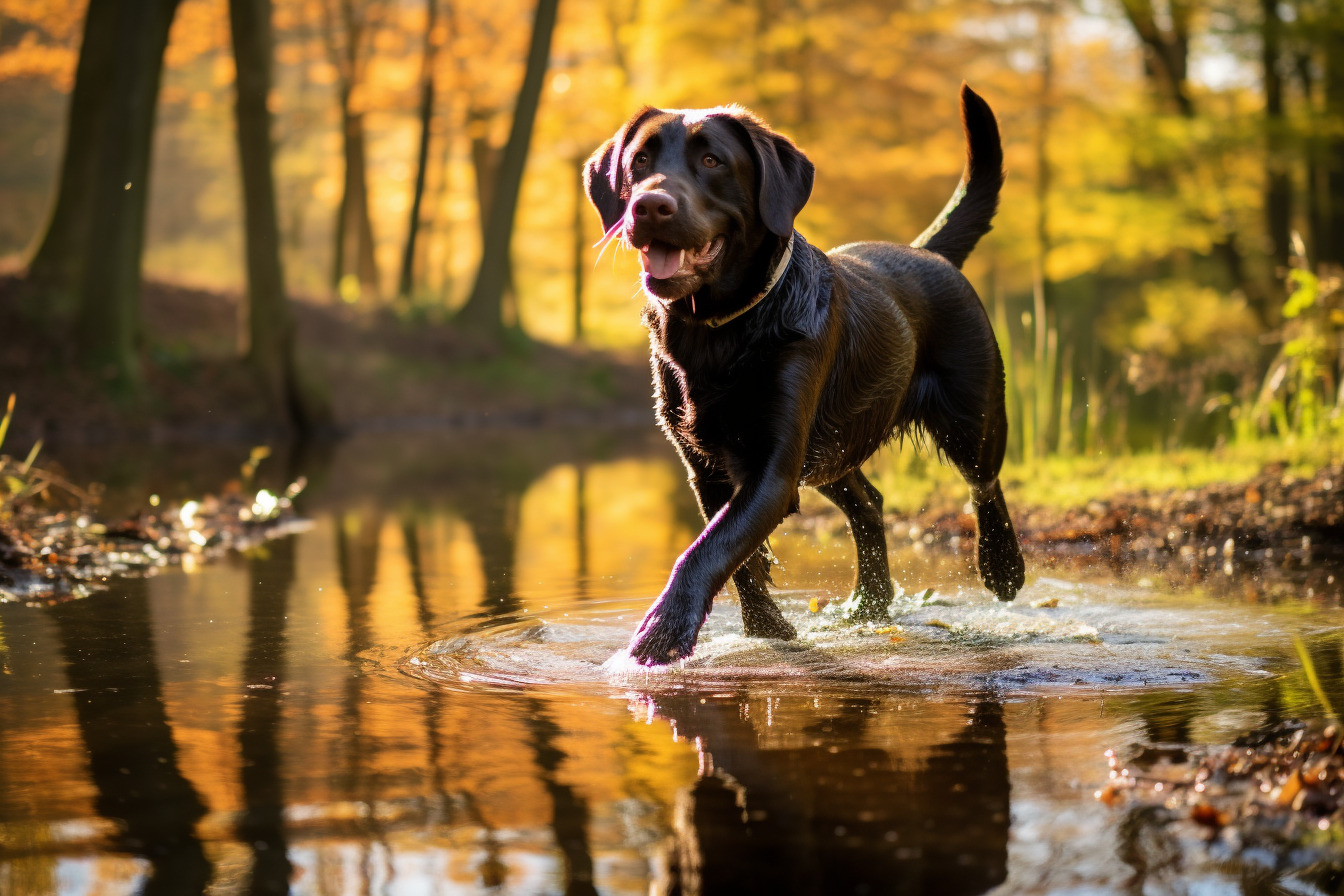
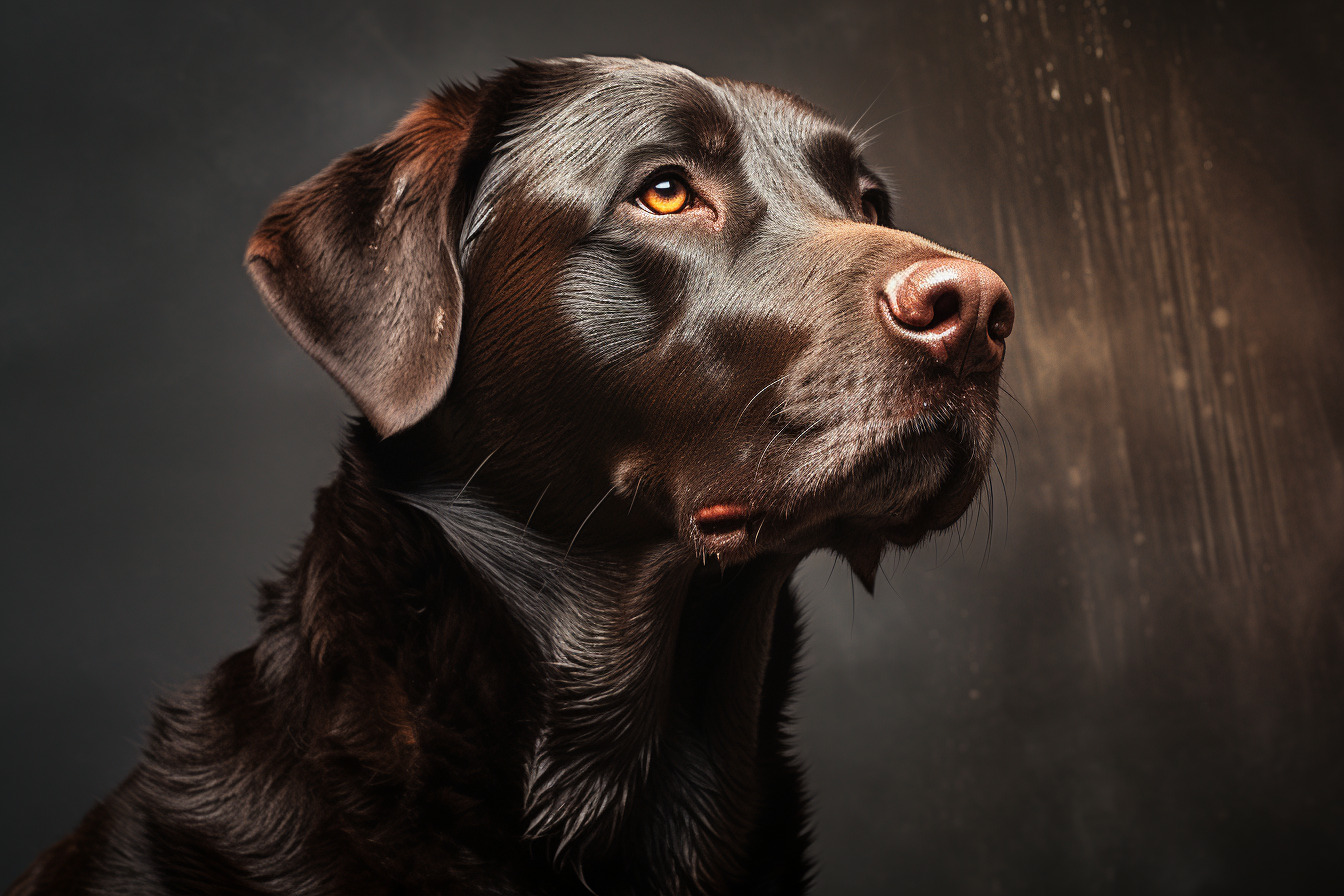
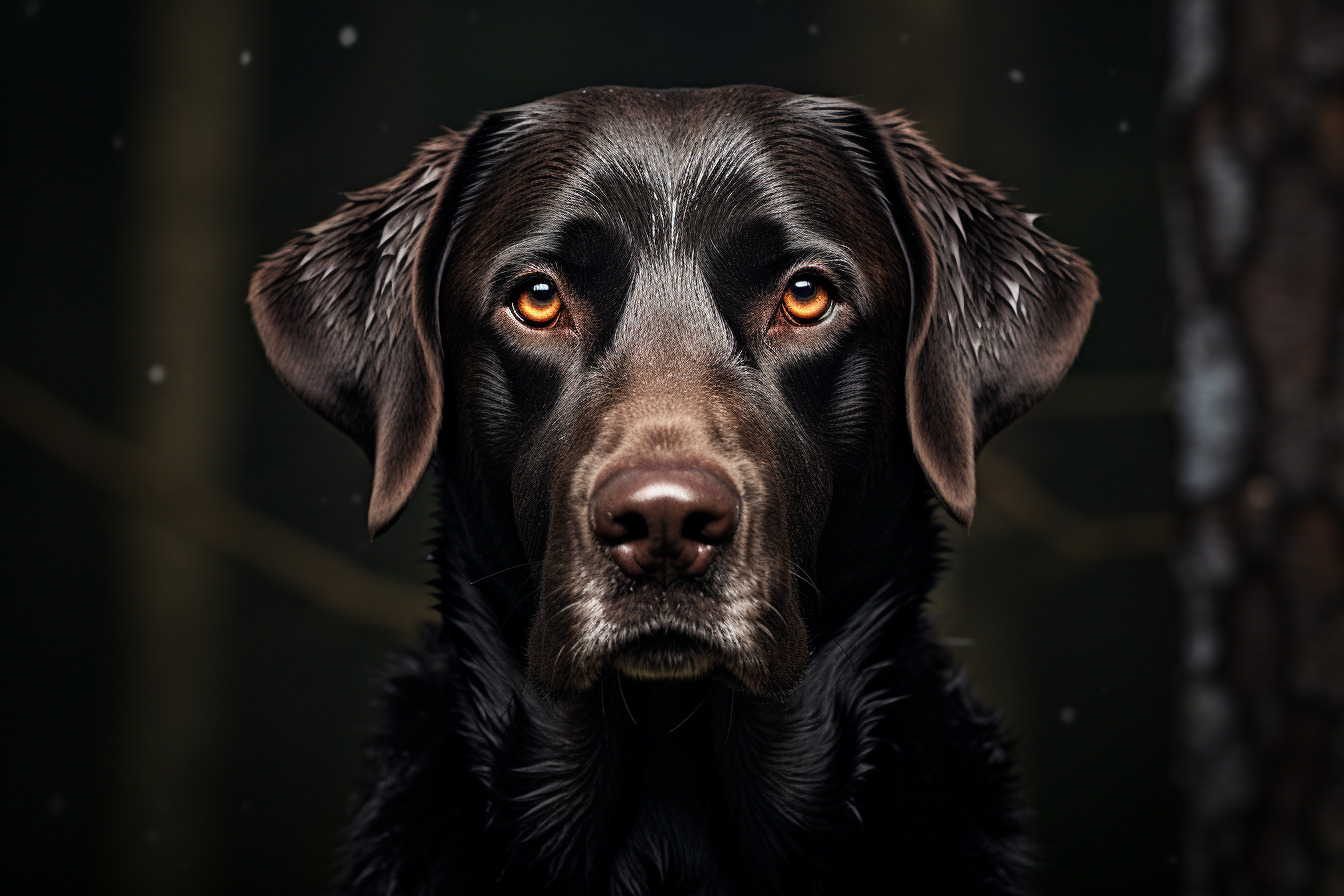
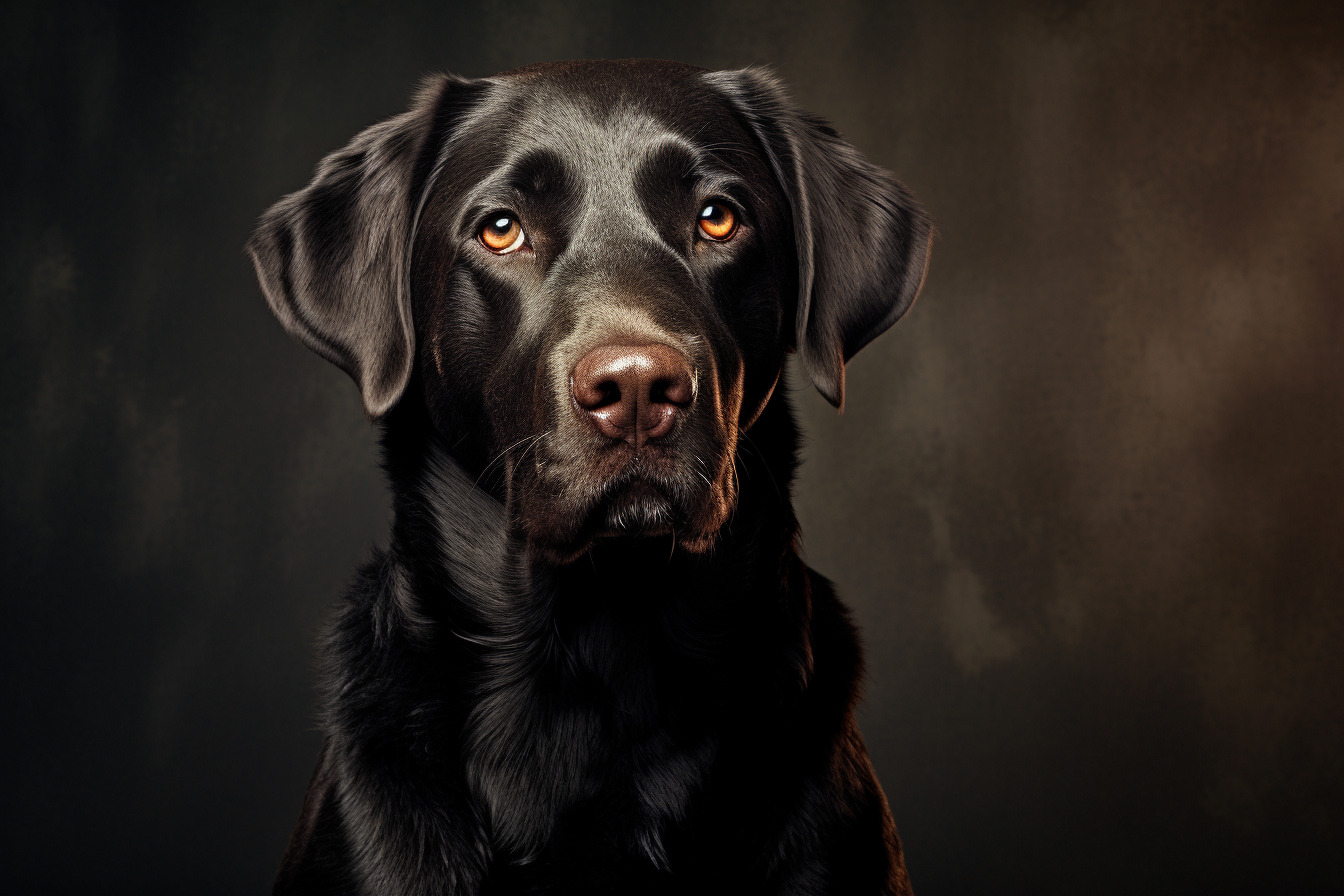

Overview
Labrador Retrievers are a favorite among dog lovers for their ideal blend of physical attributes and good-natured personalities. Originating from Golden Retriever in Newfoundland, Canada, Labradors are part of the Sporting Group and are known for their robust build; male Labs weigh between 29-36 kilograms, while females are slightly lighter at 25-32 kilograms.
These dogs have a healthy lifespan, typically living 10 to 14 years. They sport a thick coat that comes in black, chocolate, and yellow colors that look great and serve as a waterproof shield, reflecting their history as excellent retrievers.
However, colors like white, silver, or charcoal, which you might see, aren’t officially recognized since they don’t meet the established breed standards.
Key Traits: Labrador Retriever Personality
Labrador Retrievers stand out for their muscular physique and water-resistant fur, which serve them well in various roles. They are known for their loyal nature, willingness to learn, and a broad range of skills that make them excellent companions in different settings. These dogs have powerful jaws, vital for picking up, carrying, and delicately holding various items.
Labradors are friendly and work well with people, which makes them easy to train. Here’s how their emotional traits link to scientific behavior:
- Devotion to their human companions is seen through their desire to be part of a group.
- Their loyalty is evident in their natural tendency to form strong bonds.
- A Lab’s playfulness comes from a higher tendency to engage in play.
- Their instinct to protect is based on natural defense behaviors.
- The way they show affection triggers the release of oxytocin, a bonding hormone, during close interactions.
These qualities explain why Labradors excel in many service roles, such as therapy and assistance. They are not just pets but also valuable helpers to those in need.
Breed Origins
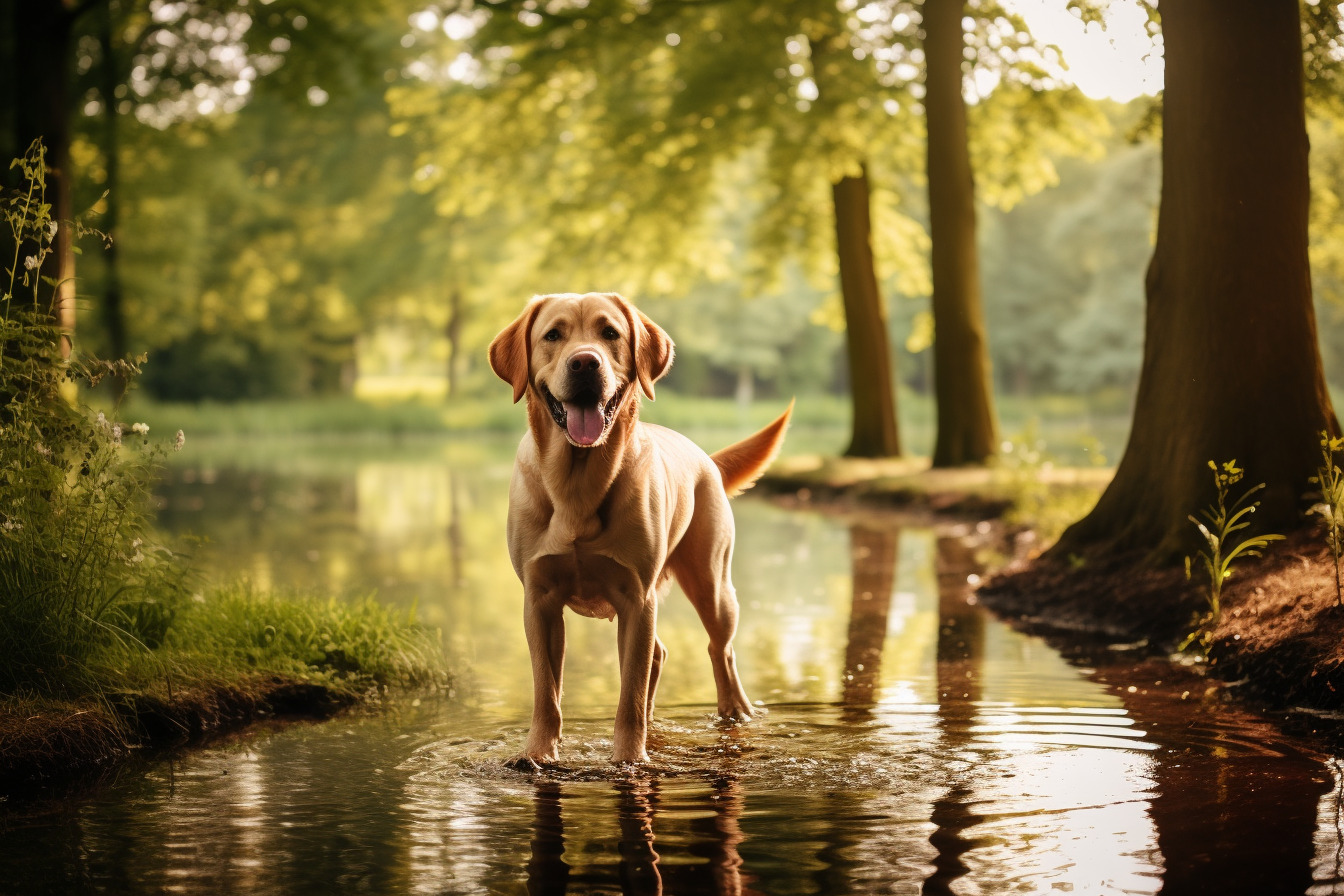
The Labrador Retriever hails from the challenging terrain of Newfoundland, Canada, where it was initially bred to help fishermen. These dogs played a crucial role on fishing boats, adeptly retrieving fishing nets and escaped lines thanks to their excellent swimming skills and diligent nature.
They are direct descendants of the St. John’s water dog, a breed that no longer exists but is critical to understanding the Labradors’ genetic makeup and behavior.
- Hails from Newfoundland’s rugged landscapes.
- They were initially bred to aid in fishing operations.
- Direct lineage from the extinct St. John’s water dog.
- It gained official recognition from the Kennel Club in the early 1900s.
Newfoundland Ancestry
The Labrador Retriever has roots in Newfoundland’s rugged coastal environment. The breed’s ancestors were St. John’s water dogs, skilled swimmers that helped fishermen by retrieving nets and lost gear from the chilly North Atlantic.
These local dogs were bred for strength, natural retrieval abilities, and friendly nature. When these dogs were brought to England in the 1800s, the Earl of Malmesbury noticed their qualities and initiated a breeding program.
His efforts were crucial in defining the Labrador’s distinctive traits, making them excellent sporting dogs and loyal companions today.
Historical Uses
Labrador Retrievers have a rich history of working alongside humans, initially as helpers for hunters and fishermen. Originating from Newfoundland and descending from St. John’s water dogs, these dogs were natural at water and land tasks.
Known for their skill in retrieving, which is even highlighted in their name, these dogs gained formal recognition from the Kennel Club in 1903. Their role in human lives evolved to include serving as gun dogs in hunting, where their strength, stamina, and eagerness to learn made them excellent at fetching games from water and thickets.
These same qualities also made Labradors the perfect choice as guide dogs for people who are blind and as service dogs for those with different disabilities.
St. John’s Dog Connection
Every Labrador Retriever can trace its family tree to the St. John’s water dog. This foundational breed was integral in shaping the versatile working dogs we know today.
Originating in Newfoundland, Canada, the St. John’s water dog was skilled in water-based tasks, helping fishermen retrieve nets and equipment. These dogs were known for their physical traits and genetic qualities, which set the stage for the Labrador Retriever’s solid build and diverse skill set.
When these dogs were brought to England in the 1800s, breeders focused on refining their traits. The efforts of the Labrador Retriever Club played a significant role in creating the breed standard.
Physical Dimensions

Keeping track of a Labrador Retriever’s size is critical to ensuring it meets the breed standards and stays healthy. You should regularly check a Labrador’s height and weight to ensure it matches what’s expected for the breed and to spot any signs of health issues early on.
Puppies must grow at the right speed to avoid future problems related to their size. For Labradors, the ideal weight range is set by breed experts.
The height at the withers—the highest part of the back at the base of the neck—is also specified for these dogs. Different body shapes can occur, but they should all fit within the breed’s guidelines.
Monitoring a puppy’s growth and hitting key milestones helps to keep them on the right track for healthy development.
Breed Average Weight
Male Labrador Retrievers generally weigh between 65 and 80 pounds, while females are lighter, usually ranging from 55 to 70 pounds.
As the most beloved dog breed in the United States, Labradors are expected to meet specific size standards that promote good health and suitability for their traditional role as fetching dogs in watery habitats. These robust dogs have a muscular frame and a dense, water-repellent coat that adds to their heft.
Breed standards are not just about appearance but also about health. If a Labrador’s weight strays from the ideal range, it could be a sign of health problems or a deviation from the breed’s typical build.
That’s why dog owners and breeders must watch their Labradors’ weight.
Standard Height Range
Knowing the right height for male and female Labrador Retrievers helps keep these dogs healthy and accurate to their breed. Per the American Kennel Club guidelines, males should measure between 22.5 and 24.5 inches, while females should be slightly shorter at 21.5 to 23.5 inches.
These measurements reflect a balanced Labrador, vital for their physical abilities and health. Breeders and dog owners should regularly check these sizes to ensure Labs are healthy and meet the official standards set by the Labrador Retriever Club.
Body Shape Variations
Labrador Retrievers come in various body shapes and sizes, ranging from stocky to slim and athletic. These differences, especially in chest width, leg length, and the strength of the hindquarters, affect their overall look, how well they move, and how much stamina they have.
Studies show these physical traits are important because they can influence the dog’s health. Labradors are prone to hip and elbow dysplasia, and these conditions can be made worse by poor body proportions and being overweight.
Breeders focus on these aspects to reduce the chances of these joint problems and keep the breed healthy and active.
Growth Rate Benchmarks
Labrador Retrievers are known for their friendly nature and adaptability, but monitoring their growth is vital.
Male Labradors should typically measure between 22.5 and 24.5 inches in height and weigh 65-80 pounds, while females should stand at 21.5 to 23.5 inches and weigh between 55 and 70 pounds.
Keeping an eye on these growth measurements is critical for assessing a Labrador’s health and development. If a Labrador’s size strays from these standards, it might indicate health concerns or dietary deficiencies that require a vet’s attention.
Maintaining these benchmarks helps Labradors stay in prime condition, reflecting their muscular, athletic build associated with the Sporting Group of dogs. Regular growth checks can also contribute to their expected lifespan of 11 to 13 years.
Size-Related Health Issues
The health of a Labrador Retriever can be significantly affected by its size. If a Labrador doesn’t match the breed’s standard size, it could face serious health problems.
Overweight dogs are at risk of joint issues, like hip and elbow dysplasia, which can lead to painful arthritis. Being overweight also puts Labradors at risk for heart and breathing conditions, especially tricuspid valve dysplasia, which affects heart function by disrupting blood flow.
To prevent these health concerns, it’s essential to keep Labs at a healthy weight by following dietary guidelines and closely watching their growth.
Pet Parents Temperament Traits
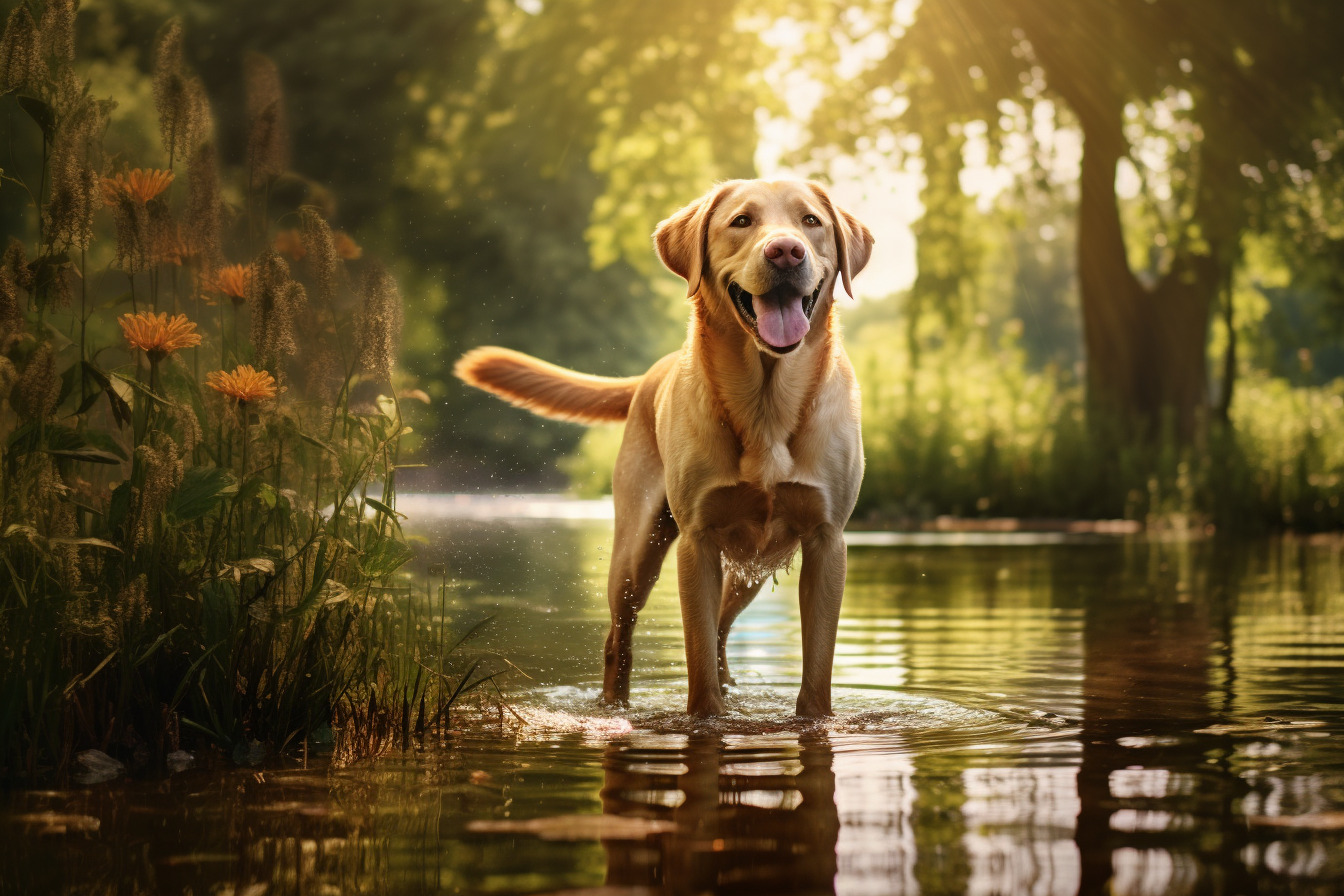
The Labrador Retriever is an excellent choice for families and individuals due to its well-rounded personality. These dogs are energetic and kind, but they thrive when they regularly interact with people and receive training to guide their talents and keep their behavior balanced.
Labradors are often chosen for roles like service or therapy work because they’re friendly and respond well to human direction. Perfect for the home, Labradors are affectionate and devoted, fitting smoothly into family life.
These active dogs need plenty of exercise every day to stay happy and healthy, both mentally and physically. They learn quickly and are eager to please, which makes training them a positive experience.
Their calm and patient nature makes them great companions for kids and peaceful cohabitants with other pets.
Friendly Family Companion
Labrador Retrievers are known for their friendly, patient, and trainable nature, making them perfect pets for families. These dogs are loved for their easy-going personality and ability to fit right into the daily life of a home.
They listen well and always look to make their owners happy, making them a breeze to train for various household roles. Their love for fun makes them great playmates for kids and get along with other pets.
To keep a Labrador happy and well-behaved, it’s essential to provide them with regular mental and physical activities. This helps prevent them from getting bored and wandering off.
Labradors are versatile dogs, happy to fetch a ball in the backyard or take on more challenging tasks outdoors.
High Energy Levels
Known for their friendly nature, Labrador Retrievers are energetic dogs that need regular exercise and play to stay happy. They have a lot of stamina and need daily physical activities and mental challenges to keep their behavior in check.
Labs might start showing unwanted behaviors due to their pent-up energy if they don’t get enough stimulation. They love having a routine that includes their natural love for fetching and swimming.
Owners should ensure their Labs get plenty of exercise and mental challenges daily to keep them from getting bored and help them be well-behaved pets.
Easy Trainability
Labrador Retrievers stand out for their cooperative nature and ease of training, making them one of the most teachable dog breeds. Their intelligence is critical when they serve as guide dogs or in search and rescue teams.
Labs naturally take to following human instructions and often excel in obedience due to their friendly nature. They respond well to training that involves rewards and positive feedback, which aligns with their desire to please their owners.
When Labradors receive consistent and well-structured training, they quickly learn and perform complex tasks, confirming their reputation as adaptable and trustworthy pets. Their willingness to learn and adaptability make the training experience smoother for the dog and the trainer.
This ability to learn efficiently is why Labradors are valued in various service roles and beloved family pets.
Gentle Disposition
Labrador Retrievers are well-loved for their friendly nature and patience, making them perfect pets for families. They fit nicely into a home, bringing peace and joy as they interact gently with kids and other pets.
Labradors strike the right balance between being calm and active, always ready for a game of fetch or a walk, which keeps them healthy and mentally stimulated. Their kind temperament and ability to get along with everyone make them excellent companions in any household.
Socialization Importance
Socializing Labrador Retrievers is essential for their friendly nature to flourish. This involves exposing them to various people, animals, and environments. It helps shape their brain and behavior, making them nice and well-behaved.
Labradors are naturally sociable and need regular interaction to prevent fear and aggression. A mix of physical and mental challenges is crucial to balance them and stop bad habits like wandering.
A well-planned socialization routine is vital for Labs to grow into happy, friendly pets.
Labrador Retriever Health Conditions

Labrador Retrievers are known for their strength and friendly nature but face some health challenges. For instance, they often inherit conditions like hip and elbow dysplasia, which can cause discomfort and mobility issues.
These conditions require breeders to screen their dogs carefully and choose healthy mating pairs to reduce the chances of passing down these ailments. Maintaining a Labrador’s weight with a proper diet and regular exercise is crucial.
Overweight dogs can suffer more intensely from joint problems and are at risk of developing other health issues. Regular eye exams are also vital to Labs, as they can inherit eye conditions that may affect their vision.
Genetic Disorders Risk
Labrador Retrievers are generally robust dogs but can inherit health issues like hip and elbow dysplasia, various eye conditions, and a tendency toward obesity. Hip and elbow dysplasia involve multiple genes and can cause joint malformation, leading to pain and mobility issues.
Eye problems in Labradors may include progressive retinal atrophy, which leads to blindness, cataracts, and retinal dysplasia. Obesity in these dogs can worsen joint issues and increase the risk of metabolic and heart diseases.
Chocolate Labradors notably have a shorter lifespan and are more prone to health problems, highlighting the need for responsible breeding to reduce these risks. Breeders and prospective owners should be aware of these inherited conditions to ensure these beloved dogs’ long-term health and well-being.
Obesity Management
Keeping your Labrador Retriever at a healthy weight is critical to avoiding health problems caused by obesity. Vets often suggest a plan that balances diet and exercise. Tailoring the amount of food to the dog’s metabolism, age, and activity level is vital. A diet rich in protein and fiber but low in fat can help stop weight gain.
Regular exercise is just as important as diet for preventing obesity. It helps burn calories and keeps muscles toned. When Labradors get enough physical activity and eat well, they’re less likely to become overweight. This can improve joint health and reduce the risk of hip dysplasia and eye problems.
Hip Dysplasia Prevalence
Keeping Labrador Retrievers healthy involves more than managing their weight; it also means paying attention to hip dysplasia.
This condition, where the hip joint doesn’t form correctly, causes joint looseness, arthritis, and pain for the dogs. Since Labradors are genetically prone to Canine Hip Dysplasia (CHD), breeders must be responsible. They should screen dogs carefully before breeding, using X-rays to check the hips and get a hip score.
The widespread occurrence of hip dysplasia in Labradors highlights why these steps are necessary. Vets usually suggest managing the dog’s weight, ensuring they get the right amount of exercise, and sometimes even surgery to help dogs with this condition move better and feel less pain.
Labrador Retriever Grooming: Maintenance Requirements

Labrador Retrievers need a solid care plan covering their physical and health needs. A suitable care plan helps these dogs live a healthy and happy life.
Keep up with grooming by brushing them every two weeks and giving baths when necessary. Daily physical activities and brain games keep them mentally and physically fit.
Feed them carefully measured meals to avoid weight gain. Also, take them to the vet twice yearly for checkups to catch any health issues early.
This approach to their care ensures Labs stay in top condition throughout their lives.
Grooming Frequency
Labrador Retrievers must be brushed weekly to keep their coats healthy and manage shedding. Their skin has a double coat: a thick outer layer with a soft, insulating layer underneath.
This helps them regulate their body temperature and stay protected from water and dirt. Regular brushing removes dead hair and spreads the dog’s natural oils through their coat, giving it a healthy shine and helping to repel water.
Regular grooming can prevent skin problems and keep a Labrador’s coat in great shape.
Exercise Regimen
Labrador Retrievers thrive with regular exercise that keeps them physically and mentally stimulated. They’re an energetic breed that loves to stay active, so a varied workout plan is vital.
Your Lab will enjoy aerobic exercises like swimming and fetch games, which are great for their heart and match their natural love for retrieving.
In addition to physical activities, it’s wise to mix in brain games and consistent training to keep their minds sharp.
Tailor the intensity and length of their workouts to their age, health, and stamina to avoid any harm while still meeting their needs for activity.
Feeding Schedule
Switching from regular workouts and setting up a consistent feeding schedule for your Labrador Retriever is vital to keep them healthy and energetic.
Each dog has different dietary needs based on their activity level and metabolism, so it’s best to get advice from a vet to determine the right amount of food and how often to feed them.
Labradors are known to gain weight quickly, so sticking to a well-planned diet helps prevent obesity and related health issues.
They also need a diet of proteins and essential nutrients to maintain their strong muscles and active lifestyle.
Health Checkups
Regular vet visits are crucial for keeping your Labrador Retriever healthy. These checkups often include x-ray screenings to spot issues like Canine Hip Dysplasia (CHD), elbow dysplasia, and Osteochondritis Dissecans (OCD).
It’s also a good idea to test thyroid function regularly to prevent metabolic disorders like hypothyroidism. Inspecting your Labrador’s coat during these visits can reveal the first signs of skin problems, such as hot spots that might point to allergies or infections.
Getting ahead of these issues properly can keep your dog’s skin healthy. Regular eye exams are also a smart move to prevent vision problems like progressive retinal atrophy and cataracts.
Training Commitment
Quality training is essential for a Labrador Retriever, forming part of their care alongside regular health checkups. It ensures they grow into well-behaved pets. Labs are naturally intelligent, making them suitable for complex roles like search and rescue or as service dogs.
Because of this, they need a steady and well-planned training schedule. Programs such as the Canine Good Citizen (CGC) and AKC S.T.A.R. Puppy help set clear goals and offer a way to track a dog’s progress.
Also, getting your Labrador involved in dog sports can sharpen their obedience, keep them fit, and strengthen your bond with them. This is vital for their overall happiness and health.
Dietary Needs
Labrador Retrievers need a diet tailored to their unique nutritional needs to stay healthy, especially since they’re prone to gaining excess weight and related health issues. Creating a feeding plan that matches their activity levels is vital to supplying them with the proper nutrients through every stage of their lives.
It’s also essential to consider their genetic risks, such as joint problems and other health issues common to the breed.
- Balanced Diet: Labradors should have a diet with suitable proteins, carbs, fats, vitamins, and minerals.
- Meal Schedule: It’s best to have regular meal times and control how much they eat at each sitting.
- Tailored Nutrition: Adjust their food based on age, how active they are, and their health.
- Healthy Weight: Implement strategies to prevent excess weight gain and keep them in good shape.
Balanced Nutritional Requirements
Labrador Retrievers, known for their lively nature, need a diet high in proteins, fats, and carbs to meet their energy requirements and stay healthy. Proteins support tissue repair and keep their coats glossy. Fats are a dense energy source and help uptake vitamins that dissolve in fat.
Carbs provide quick energy and aid in digestive health. To ensure a Labrador Retriever’s diet supports all bodily functions and prevents nutrient shortages, it should include the right vitamins and minerals.
Watching their food intake is critical to avoiding health problems like obesity since each dog’s needs vary based on activity and metabolism. Regular vet checkups are beneficial to tailor a Labrador’s diet to their specific needs.
Feeding Frequency
Labrador Retrievers thrive on a feeding schedule of two meals per day. This routine is tailored to their energy needs and helps prevent the risk of overeating.
Proper meal timing aligns with their body’s metabolic rate, ensuring they maintain consistent energy levels and avoid unnecessary weight gain. It is essential to adjust the amount of food and its nutritional content to match your dog’s age, body shape, and activity level.
A diet with plenty of quality proteins and omega fatty acids will keep their muscles strong and their energy up. Regular checkups with your vet are crucial to tailor your Lab’s diet, especially as they age and their nutritional needs change.
Keeping an eye on your dog’s body condition score is essential to avoid obesity, a common problem in the breed. Regularly assessing their weight and body shape can help you make the proper dietary adjustments.
Special Diet Considerations
When feeding Labrador Retrievers, tailoring their meals to their unique dietary needs is crucial for their health. Labradors tend to become overweight, so providing a balanced diet that matches their activity levels is critical.
The high protein content is beneficial for maintaining muscle mass while keeping fat levels low helps prevent unnecessary weight gain. It’s also wise to include nutrients like glucosamine and chondroitin in their diet to support joint health, which is particularly important given Labradors’ risk for hip and elbow dysplasia.
Always consult a vet to ensure the diet fits your dog’s health needs and activity profile.

